No results found. Try again with different words?
Search must be at least 3 characters.
- How to Add an Extra Field for a Particular Schema Type in Schema Pro?
- How to enable/disable schema markup from post/page?
- How to Add Ratings using Shortcode in Schema Pro?
- How to disable a specific schema markup from post/page?
- How to Add Schema Markup on Subcategories
- How to Disable the White Label Settings Permanently?
- How to Disable Corporate Contact Schema?
- How to Remove Home List Item from Breadcrumblist Schema?
- How to Remove Shop Item Link from BreadcrumbList Schema on Product Page?
- How to Test a Schema Snippet?
- Mapping Your Schema Fields in Schema Pro
- How to Add an Extra Field for a Particular Schema Type in Schema Pro?
- How to Use the Schema Pro plugin?
- What is the All-in-one Schema Pro plugin?
- How to map required fields with Custom Fields?
- How to create a Custom Fields using Schema Pro?
- How to target specific areas of the website?
- How to enable/disable schema markup from post/page?
- How to Add Ratings using Shortcode in Schema Pro?
- How to Add a Schema markup for an Article on your website?
- What is the Difference between the Free and Pro Plugin?
- How to map fields with custom fields from third party plugins?
- How to Accept User Ratings from Users in Schema Pro?
- How to Update Schema Pro?
- How to Register Your Copy of Schema Pro? (License Registration)
- Selecting Organization Type in the Setup Wizard
- Schema Pro Setup Wizard
- Getting Started with Schema Pro
- How To Install Schema Pro Plugin
- How to Add a Schema markup for an Event page?
- How to Add a Schema markup for a Review page?
- How to Add a Schema markup for a Local Business Page?
- How to Add a Schema markup for a Service Page?
- How to Add a Schema markup for a Product page?
- How to Add a Schema markup for a Course page?
- How to Add a Schema markup for a Recipe page?
- How to Add a Schema markup for a Person or About Page?
- How to Add a Schema markup for a Job Posting page?
- How to Add a Schema markup for a Video Object?
- How to add Corporate Contact Markup?
- How to Add a Schema markup for a Book page?
- How to Add a Schema Markup for a FAQ Page?
- How to Add a Schema Markup for a How-To Page?
- How to Add a Schema Markup for an Article Page?
- The Difference: FAQ Schema Type & FAQ Schema Pro Block for Gutenberg
- FAQ Schema Pro Block for Gutenberg
- How-to Gutenberg Block in Schema Pro
How to Add a Schema markup for a Book page?
If you’re an author or a publisher and want to promote your book or novels even further, adding schema markup to your website is one of the best ways to increase the reach of your book. It’s easy to do and will prove to be very helpful for your overall SEO.

Enable rich snippets of your book to be shown on Google’s search results page by adding schema markup with Schema pro.
The Schema Pro plugin adds a Book schema markup to the page/post.
Let’s see how to add book page schema with easy steps –
How to Add the Book Schema Markup?
Step 1. Create a new Schema markup by going to the Schema Pro option under WordPress Dashboard > Settings > Schema Pro. Click on “Add New”.
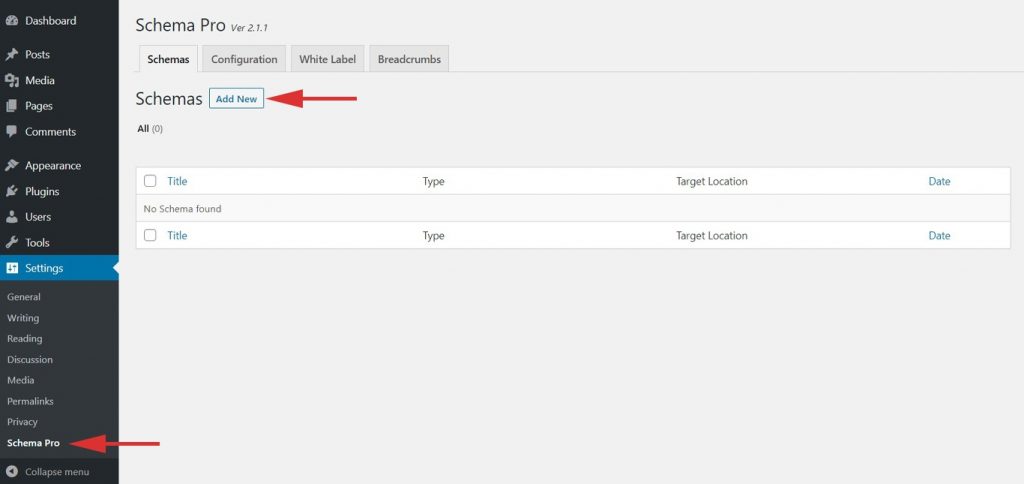
Step 2. Select the type of schema as “Book”.
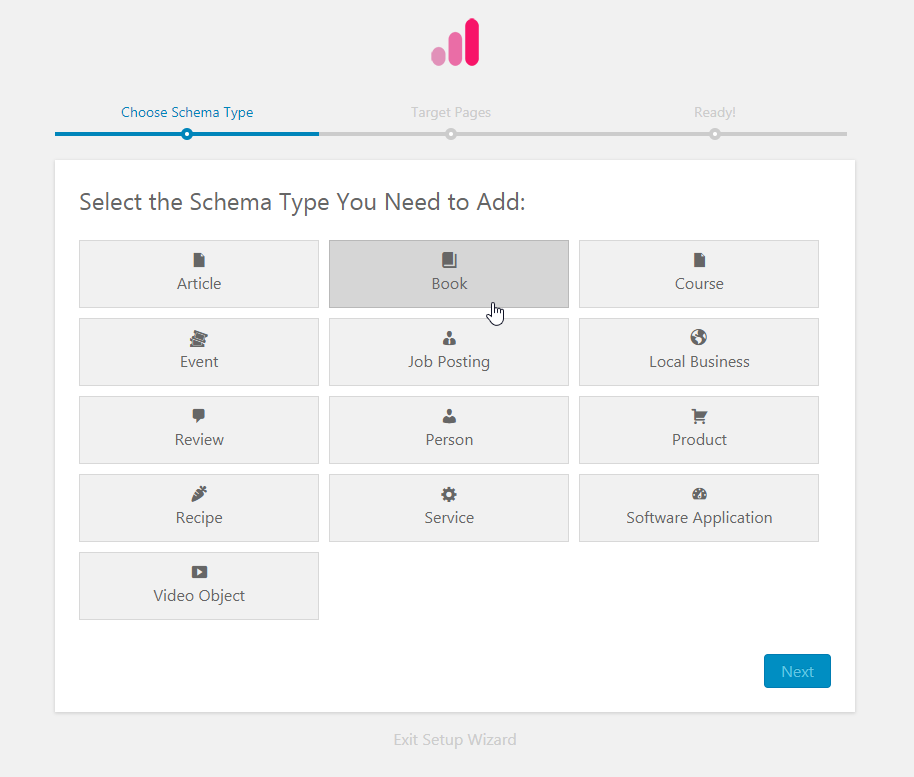
Step 3. Select the pages/posts that you want to apply this markup to. You can add display rules and also exclude pages and posts you want to exempt this schema from.
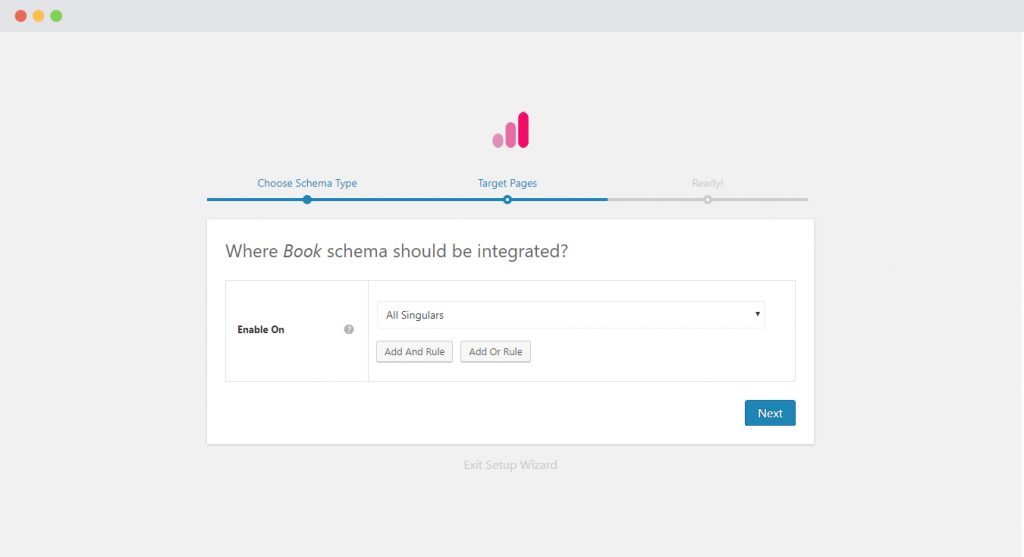
If you want to know more about how you can target specific pages and posts, check out our article on it.
Step 4. You can then complete the setup. From here you will be taken to fill the required properties of the schema.
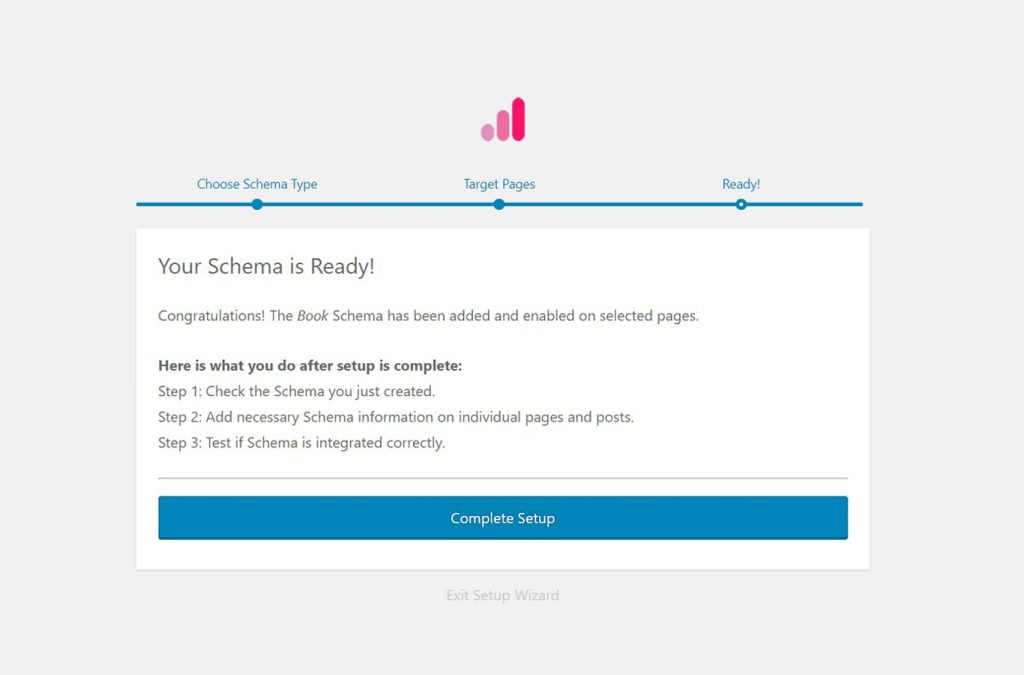
Step 5: In Schema Settings, you will see various fields related to book schema. These fields help you enter details about your book. We recommend you make sure that all schema fields are put on the right values.
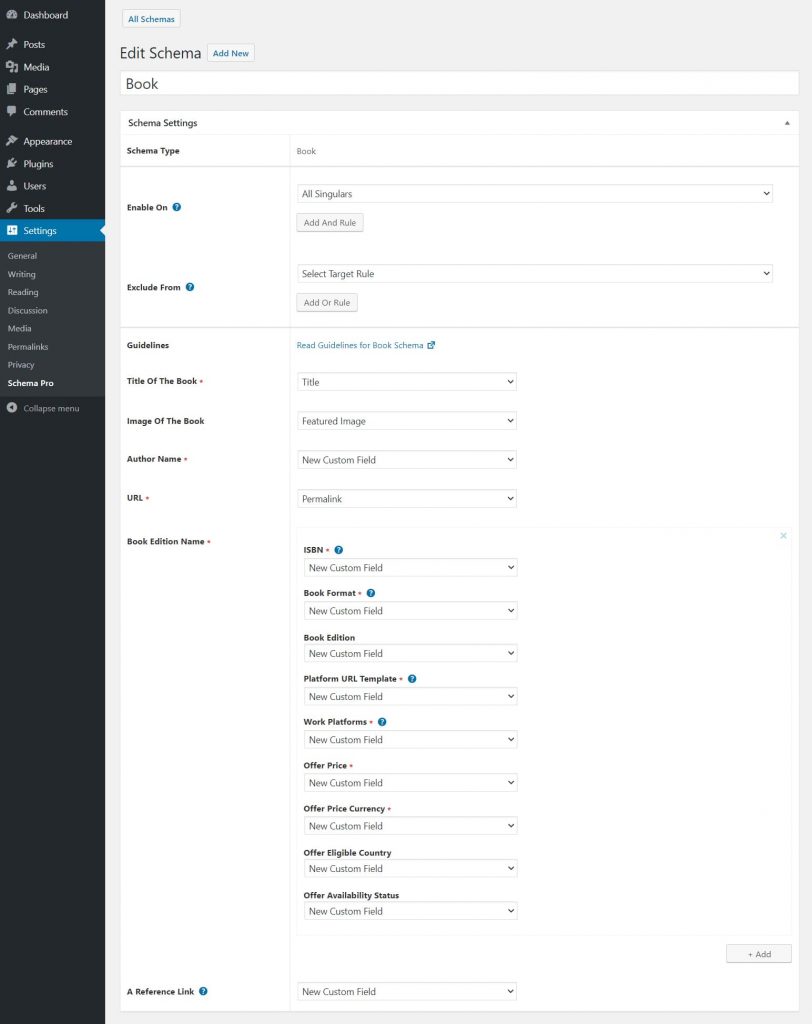
Check out the next section to understand all available fields in the book schema markup.
What Do These Fields Mean?
Let’s dive into what all the book page schema fields mean so that you can fill in the correct values.
In the following table –
– Asterisk sign (*) indicates required fields.
These fields are required by Google and if not filled out will result in an error on the Rich Snippets Test.
– Caret sign (^) indicates the recommended fields.
These fields are recommended to ensure maximum utilization of the SEO benefits of Schema Pro and will increase your chances of displaying Rich Snippets.
| Fields | What They Mean |
| Title Of The Book * | The actual and full title of the book. |
| Image Of The Book ^ | A thumbnail image related to the book. Preferably its cover art |
| Author Name * | The author of the book. |
| URL * | Link for the page on your site that will explain more information about the book. |
| Book Edition Name * | Here you will indicate all the information about the book. |
| *ISBN | ISBN number of the book. *This can be found on the book cover, or you can contact your publisher to get this information. Additional Guidelines: The ISBN can be either 10 or 13 digits, but we recommend 13 digits if available. Use the ISBN of the print book instead if there is no ISBN for the edition being described; for example, for the Kindle edition. |
| Book Format * | The format of the book Good Examples: – Paperback – Hardcover – Audiobook |
| Book Edition ^ | Edition of the Book Good Examples: – First Edition – Second Edition |
| Platform URL Template * | Links where the platform works. |
| Work Platforms * | The platform where the link/URL works on. Good Examples: – Works on Desktops – Works on Mobile Devices |
| Offer Price * | The main selling price of the book. |
| Offer Price Currency * | The main currency the book is sold |
| Offer Eligible Country ^ | The region where the book can be sold and purchased |
| Offer Availability Status ^ | The book’s availability Good Examples: – In Stock – Out Of Stock – PreOrder |
| A Reference Link ^ | A reference link that verifies the book’s identity. Good Examples: A Wikipedia linkFreebase page official Website |
Not sure how you can fill these fields? You can refer to this article that gives you a clear picture of the fields you see in the drop-down menu.
With Schema Pro you can also add extra or custom fields to your markup. Check out this article to find out how.
Configure Schema on a Single Page/Post
Once you fill the above schema fields, the values will be applied to all target locations. These values are common for all target locations.
But in case you wish to alter these values for a particular page/post, you can also find all the schema fields on each of the targeted pages/posts.
If you visit a single page/post you can see all book schema fields at the bottom.
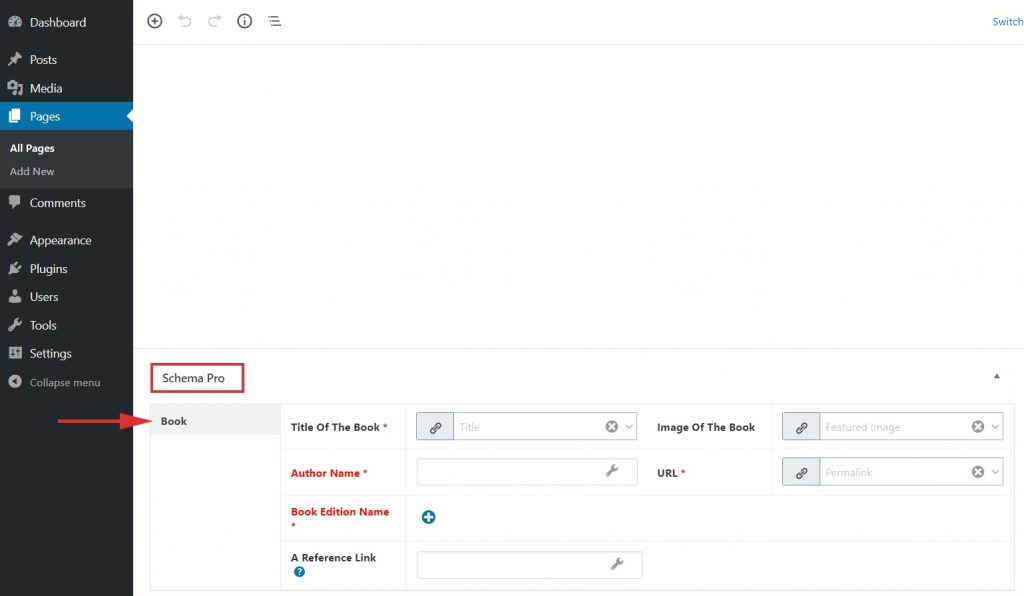
By default, all fields will fetch values from schema under Settings > Schema Pro > book but you can also change this and choose other values from the list or set the values manually.
You might see some of the fields marked in red, these are required fields in the schema that do not have any value. Skipping these fields will add invalid schema markup to the code.
Read this article here to learn more about the page-level schema configuration.
Test Your Schema
Once you are done with adding schema markup, test it to see if it sets well.
Testing can be done with just a single click with the “Test Schema” button on the admin bar. Here is an article that will show you how you can test your schema.
OR
You can manually visit the Rich Results Test tool and insert your content.

Once you’re done, you’re all set to see your book page attracting more applications through the search engine’s rich snippets!
How to Handle Errors & Warnings in a Testing Tool?
When you test your page/post with the Rich Results Test tool you might see some errors and warnings come up. Refer the article to see detailed steps to easily fix errors and warnings.
Setting up other schema types? Check them out below.
We don't respond to the article feedback, we use it to improve our support content.